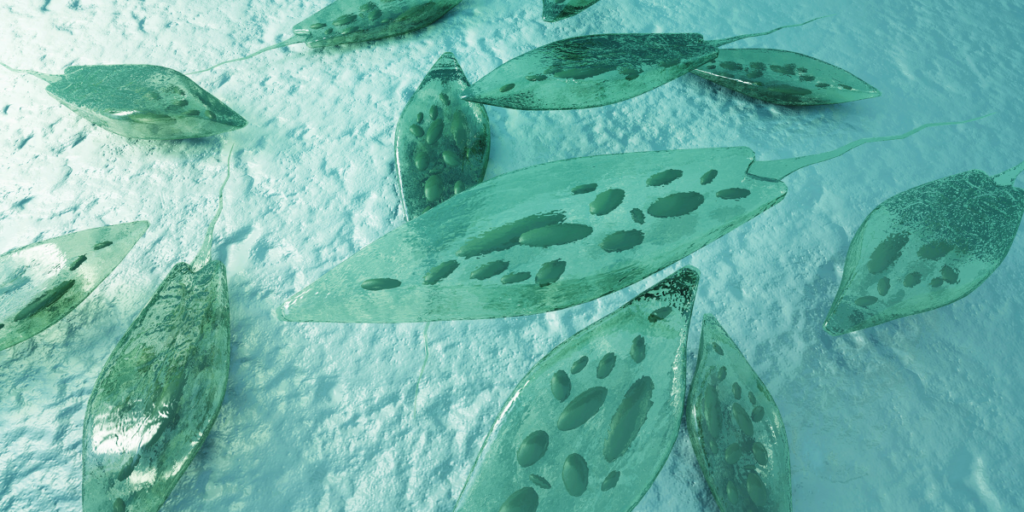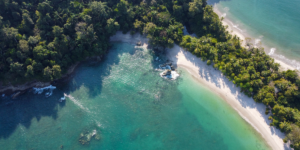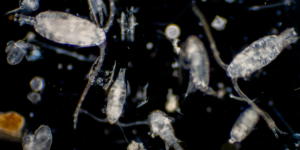When it comes to marine ecology, there are a plethora of species that play vital roles in maintaining the delicate balance of our oceans. From tiny phytoplankton to massive sharks, each species has its own unique niche and contributes to the overall health of our ocean ecosystems.
First and foremost, we must acknowledge the importance of phytoplankton. These microscopic organisms form the base of the marine food chain, providing sustenance for countless other species. Through photosynthesis, they produce oxygen and absorb carbon dioxide, playing a critical role in regulating Earth’s climate. Without phytoplankton, entire ocean ecosystems would collapse, leading to devastating consequences for both aquatic and terrestrial life.
So while they may be small in size, their impact on our planet cannot be overstated.
Key Takeaways
- Phytoplankton, seagrasses, macroalgae, and kelp forests are important species in marine ecology that provide oxygen, absorb carbon dioxide, and offer shelter and food sources for marine organisms.
- Sharks and sea otters play vital roles as top-level predators in controlling populations of prey species and preventing overgrazing of kelp forests.
- Coral reefs are biodiversity hotspots with immense economic importance, but are threatened by human activities and climate change.
- Conservation strategies for marine biodiversity hotspots involve protecting habitats, controlling invasive species, reducing pollution, and promoting sustainable fishing practices and responsible aquaculture development.
Phytoplankton
When it comes to marine ecology, phytoplankton plays a crucial role in the ecosystem. As you delve deeper into this subtopic, you’ll learn about the significance of these microscopic plants in terms of oxygen production and carbon sequestration.
Additionally, they serve as a fundamental base for the food chain, supporting a vast array of sea creatures from the smallest zooplankton to large whales.

Oxygen Production
As marine ecology is a crucial part of our planet’s ecosystem, it’s fascinating to learn about the various species that contribute to oxygen production in the ocean.
Phytoplankton are responsible for producing around 50% of the world’s oxygen through photosynthesis. This process not only benefits humans by providing us with breathable air but also plays a significant role in mitigating the impact of climate change.
However, phytoplankton are not the only species that contribute to oxygen production in marine ecosystems. Seagrasses and macroalgae also play a critical role in generating and maintaining oxygen levels in coastal regions. These plants produce oxygen during photosynthesis and create habitats for many other organisms.
By understanding the importance of these species, we can better protect them and maintain healthy marine ecosystems for generations to come.
Carbon Sequestration
You can appreciate the significance of carbon sequestration in ocean ecosystems, where certain organisms absorb and store atmospheric carbon dioxide to mitigate climate change. Here are some potential discussion ideas about carbon sequestration:
- Carbon storage: Phytoplankton and other marine organisms use photosynthesis to convert carbon dioxide into organic matter that sinks to the bottom of the ocean. This process removes carbon from the atmosphere and stores it in deep-sea sediments for centuries or even millennia.
- Impact of ocean acidification: As the concentration of atmospheric CO2 increases, more of it dissolves into seawater, making it more acidic. This can have negative effects on marine life, especially those with shells or skeletons made of calcium carbonate, such as corals and mollusks. However, some research suggests that increased levels of CO2 may also stimulate algal growth and enhance carbon sequestration in certain areas.
Carbon sequestration is an important process in marine ecology that helps regulate global climate by removing excess atmospheric CO2. Understanding how different species contribute to this process and how it is affected by environmental changes is crucial for mitigating the impacts of climate change on our planet’s oceans.
Base of the Food Chain
Imagine being a small fish in the open ocean, constantly on the hunt for food to survive. One example of a predator at the base of the food chain is the lanternfish, which makes up nearly 65% of all deep-sea fish biomass.
These small, bioluminescent fish play an important role in marine ecology as they serve as a crucial source of food for larger predators such as sharks and whales. Ecologically significant, lanternfish also help regulate trophic interactions by consuming zooplankton and smaller fish, controlling their populations.
In turn, this helps prevent overgrazing on phytoplankton, which are crucial producers of oxygen through photosynthesis. Without these tiny but mighty creatures at the base of the food chain, it’s likely that marine ecosystems would be thrown off balance with potentially disastrous consequences for both marine life and humans who rely on healthy oceans for survival.
Sharks
Sharks, with their impressive hunting abilities and crucial role in regulating ocean ecosystems, are some of the most important species in marine ecology. Despite their intimidating reputation, these apex predators play a vital role as top-level predators by controlling populations of prey species and maintaining a healthy balance in the food chain.
However, sharks face numerous threats such as overfishing, habitat loss, pollution, and climate change. This has led to declining shark populations worldwide, which is concerning for both conservation efforts and the tourism industry.
Many countries have implemented shark conservation measures to protect these misunderstood creatures and encourage responsible shark tourism practices. It’s important for us to recognize the importance of sharks in our oceans and take action to ensure their survival for future generations.
- Sharks help maintain a healthy ecosystem by controlling prey population
- Shark populations are declining due to various threats
- Conservation efforts are necessary for shark sustainability
Sea Otters
Sea otters, known for their cute and cuddly appearance, play a crucial role in maintaining the health and diversity of nearshore marine ecosystems.
These marine mammals are apex predators that feed on sea urchins, crabs, clams, and other invertebrates. By controlling the populations of these prey species, sea otters help to prevent overgrazing of kelp forests.
Kelp forests are important habitats for many fish species and other marine organisms. They provide shelter from predators, food sources, and breeding sites.
Conservation efforts have been put in place to protect sea otters as they were once hunted almost to extinction for their fur. Today, their population is still threatened by oil spills, pollution, habitat loss due to coastal development, and fishing nets.
The impact of declining sea otter populations on kelp forests has been observed in areas where they have disappeared. Without sea otters regulating the population of herbivorous invertebrates such as sea urchins or crabs which graze on kelp forests can be overgrown leading to a lack of sunlight reaching the forest floor causing it to die off.
Therefore conservation efforts must continue so that these charismatic creatures can continue playing their vital role in marine ecology.

Coral Reefs
As you delve into the world of coral reefs, you’ll discover that they’re one of the most important biodiversity hotspots on our planet.
These underwater ecosystems support a staggering array of marine life, with over 25% of all known marine species calling them home.
Beyond their ecological significance, coral reefs also have immense economic importance for coastal communities around the world who rely on them for food, tourism, and protection from storms.
However, these vital ecosystems face a range of threats including climate change, overfishing, pollution, and habitat destruction – prompting urgent conservation efforts to protect these vibrant underwater worlds before it’s too late.
Biodiversity Hotspots
Located in various regions around the world, biodiversity hotspots are areas of high ecological importance due to their concentration of unique and threatened species. These hotspots are identified based on their high levels of endemism, meaning that a large percentage of the species found there are not found anywhere else on Earth.
In addition to being home to numerous endangered species, biodiversity hotspots also play a crucial role in maintaining ecosystem function. Conservation strategies for these areas typically involve protecting habitats from destruction and fragmentation, controlling invasive species, and reducing pollution. However, given the vastness of some hotspot regions and limited resources available for conservation efforts, prioritization is key.
Deciding which areas should be protected first requires careful consideration of factors such as the level of threat facing particular species and habitats, as well as the potential impact that conservation efforts could have on local communities. By focusing conservation efforts on biodiversity hotspots, we can help protect some of the most important and fragile ecosystems on our planet while preserving countless unique and irreplaceable species for future generations.
Economic Importance
One cannot underestimate the impact of biodiversity on our economy, as it provides us with valuable resources and services that contribute to our well-being.
In the marine world, sustainable fishing is one such resource that generates billions of dollars in revenue annually. The fishing industry provides employment opportunities for millions around the world and supplies food to billions of people. However, overfishing has caused a decline in many fish populations, threatening both livelihoods and food security.
To counteract this problem, aquaculture development has become increasingly important. Aquaculture involves cultivating aquatic organisms under controlled conditions rather than relying solely on wild-caught seafood. This not only helps to reduce pressure on wild fish populations but also promotes sustainable practices in seafood production.
By providing a stable supply of seafood and creating jobs in coastal communities, aquaculture can help support local economies while also reducing pressure on already depleted wild fisheries. Thus, by supporting sustainable fishing practices and promoting responsible aquaculture development, we can ensure that marine biodiversity continues to play an important role in our economy for generations to come.
Threats and Conservation Efforts
Now that we’ve discussed the economic importance of certain marine species, it’s important to acknowledge the threats faced by these organisms and the need for conservation efforts.
Marine ecosystems are under immense pressure from human activities such as overfishing, pollution, habitat destruction, and climate change. These factors have significant impacts on the health of marine environments and their inhabitants.
Marine conservation initiatives aim to address these threats through various strategies such as protected areas, sustainable fishing practices, restoration of degraded habitats, and education programs. However, with the increasing impact of climate change on marine ecosystems, it’s becoming increasingly urgent to take action.
Rising temperatures, ocean acidification, and sea level rise are all having profound effects on marine life including altered migration patterns, changes in food availability, and increased vulnerability to disease. Therefore, it’s crucial that we continue our efforts towards protecting our ocean’s biodiversity before it’s too late.
Frequently Asked Questions
How do marine species contribute to the overall health of our planet’s ecosystems beyond their individual roles?
Marine species contribute to ecosystem health in myriad ways beyond their individual roles. Biodiversity conservation is vital for maintaining ecological networks, which support the overall health of our planet’s ecosystems.
What are the main threats to marine species and their habitats, and what can be done to address them?
To address threats to marine species and habitats, conservation efforts must focus on reducing pollution, protecting critical habitats, and promoting sustainable fishing practices. This requires cooperation between governments, industries, and individuals to ensure the long-term health of our oceans.
How do climate change and ocean acidification affect marine ecosystems and the species that inhabit them?
Climate change and ocean acidification have devastating impacts on marine ecosystems, including coral bleaching and decreased phytoplankton populations. These changes disrupt food webs, alter species distributions, and threaten the overall health of our oceans.
What are some lesser-known but important marine species that play crucial roles in maintaining ecosystem balance?
You may be surprised to learn that some lesser-known marine species are actually crucial for ecosystem balance. Certain species rely on symbiosis, while others act as keystone species. Understanding their importance is vital for effective conservation efforts.
How do human activities such as pollution, overfishing, and coastal development impact marine species and their habitats?
Human activities such as pollution and overfishing can have serious consequences for marine species and their habitats. Pollution impacts water quality, while overfishing can disrupt food chains. Coastal development also destroys important habitats, further threatening marine life.




